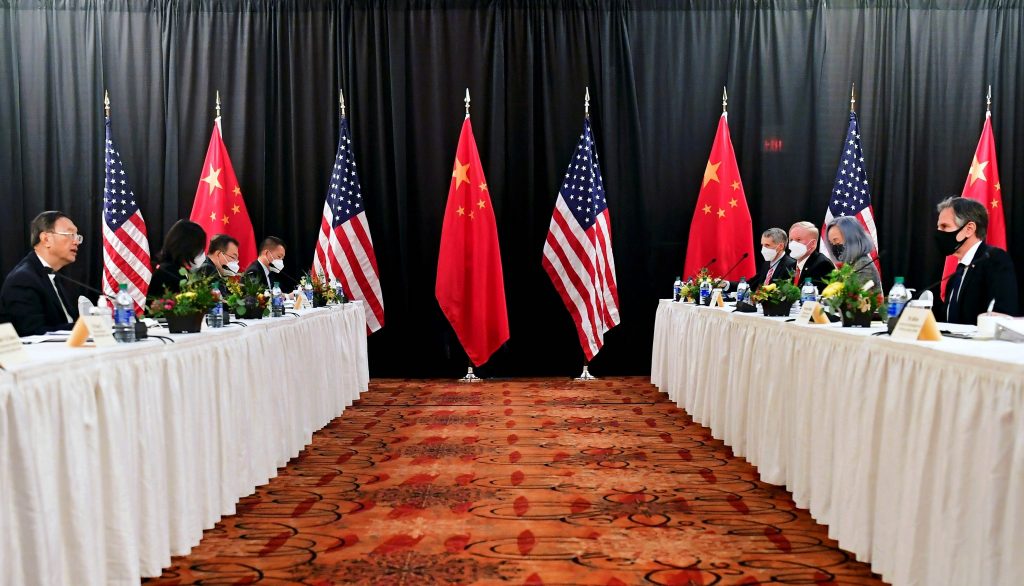Climate change is the ultimate test of whether it is possible for countries both to compete for global dominance and collaborate to save the world. If the United States and China cannot work together on this issue, they cannot work together anywhere. Together, the two powers are responsible for over 40% of carbon dioxide emissions.
Hence, many worry that without Sino-American cooperation to reduce emissions, no meaningful progress will be made. We will all be doomed. Even though both sides know that they must act rapidly to prevent a climate catastrophe, the latest evidence suggests that conventional diplomacy is not working.
In the first US-China meeting of the Biden era, in Alaska in March, China’s senior Foreign Affairs official, Yang Jiechi, launched a tirade against US Secretary of State Antony Blinken after Blinken called out China’s human-rights record. Then, in April, Biden’s climate envoy, former Secretary of State John Kerry, became the first senior administration official to visit China, where he met with his counterpart, Xie Zhenhua. The two have talked more than a dozen times since, yet it is not clear that they have achieved anything.
It is becoming increasingly obvious that there is little chance of one side coaxing the other to improve its performance through traditional diplomatic channels. The US strategy has three fundamental problems.
For starters, the international community has factored into its own strategic calculus the possibility that Donald Trump – or at least Trumpism – will return to power in the US. Second, the Biden administration is insisting that climate policy be separated from other issues (hence Kerry’s forceful rejection of the idea that China can buy America’s silence on human rights). But China insists that “climate cooperation cannot be separated from the wider environment of China-US relations.” That leaves the two at loggerheads.
The third problem is the most intractable. Even before the Afghanistan debacle, American power – hard and soft – was no longer what it used to be. US exhortations to China and other countries simply do not have the effect they once did.
For all the attention being paid to high-level diplomacy in the run-up to next month’s United Nations Climate Change Conference (COP26) in Glasgow, the truth is that the drivers of meaningful change lie elsewhere. The world’s response to climate change will succeed or fail on the basis of national self-interest. The question for the coming decades is which country – which system – will seize the mantle of the green global citizen. Who will be first to harness the economic benefits arising from green technologies?
The race for green tech will initially be about great-power rivalry. But self-preservation also will become a key factor. At what point will populations begin to see that climate inaction endangers them? How bad will conditions have to become before people demand radical change even in authoritarian states?
China’s national response so far has been a mixed bag. In September 2020, Chinese President Xi Jinping told the United Nations that his country would reach peak emissions by 2030 and carbon neutrality by 2060, putting it ahead of the US in formally committing to a target date for achieving net-zero emissions. But Chinese announcements since then have been less impressive.
In Xi’s UN speech this year, he broke new ground in only one area, by pledging to end China’s support for coal-fired power projects abroad. Following similar promises by South Korea and Japan, China was under growing pressure to end overseas coal financing (those three countries together have accounted for 95% of such financing since 2013). But this concession represents low-hanging fruit, considering that recipient countries have already grown wary of starting new coal projects.
Nonetheless, what matters in the Green Great Game is the choreography. China is keen to show that its announcements are issued entirely on its own terms. As Mikko Huotari, the executive director of the Mercator Institute for China Studies, explains, “The Chinese won’t be pushed around. This is a game of waiting – and hoping for the signals.”
China also has recognised the economic opportunities on offer. Already, seven of the world’s top ten wind turbine manufacturers are Chinese. The Chinese economy is now so large that it produces more renewable infrastructure than the rest of the world combined, bringing down the cost of solar, wind, and other resources.
But China also generates 53% of the world’s coal-fired power, and it is still increasing capacity. Experts say it must shut down more than 500 plants within ten years to have any chance of reaching its climate targets. So far, that is not happening. Instead, China is in the throes of a post-pandemic “smokestack recovery.” Worse, ten of its provinces recently were forced to ration energy owing to a slump in production, triggering alarm and pleas for more coal-power generation.
These issues are a front in a wider culture war taking place in China, where climate change is dismissed by nationalists as “Western pseudo-science” and denounced as a conspiracy to curtail the country’s growth.
As COP26 approaches, the bidding war for green credentials will intensify amid virtue signaling and admonishments. It will be important to remember that this is a proxy battle taking place within a wider cold war. China and America’s competitive instincts will propel them to outshine each other in new technologies and surprise announcements. Ultimately, more would be achieved if suspicions were reduced and collaboration increased. But in today’s new world, the old diplomacy is dead.
The writer is a consulting fellow at Chatham House. ©Project Syndicate.

